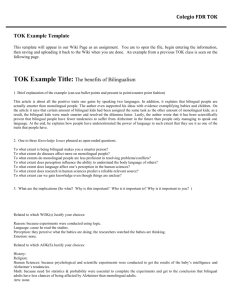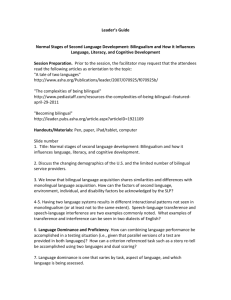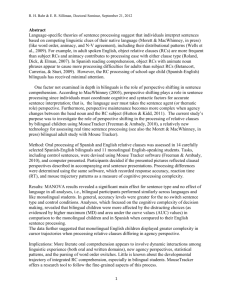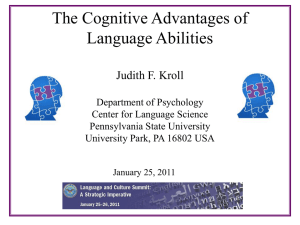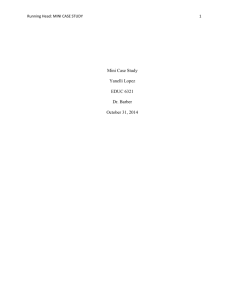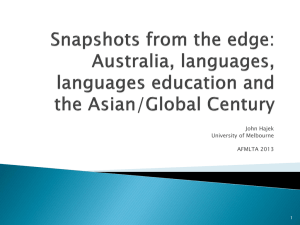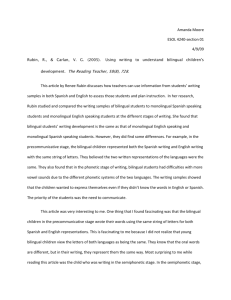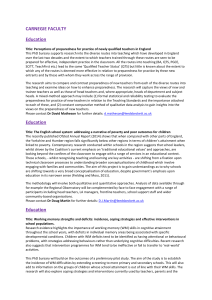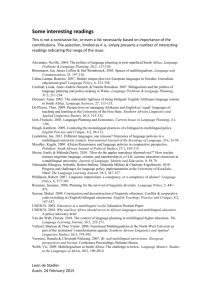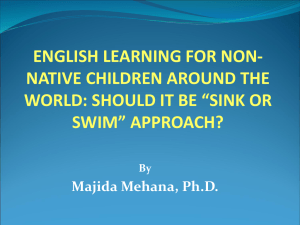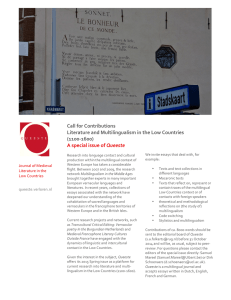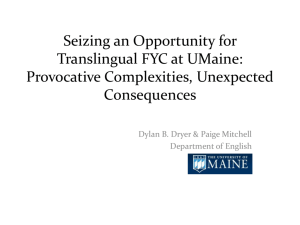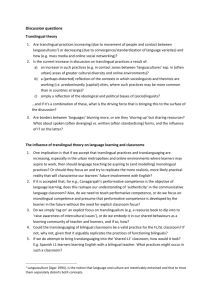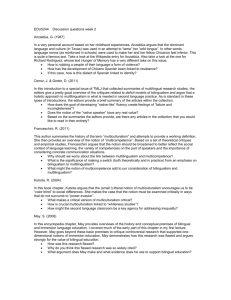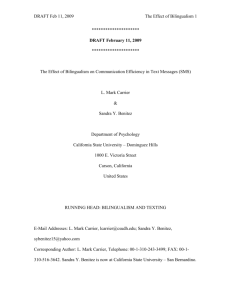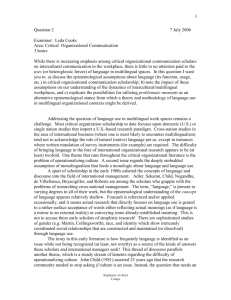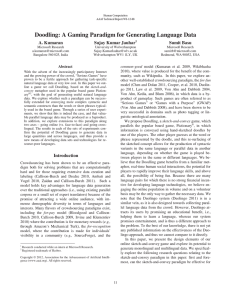Speech for Dutch community Thank you for inviting me to speak this
advertisement
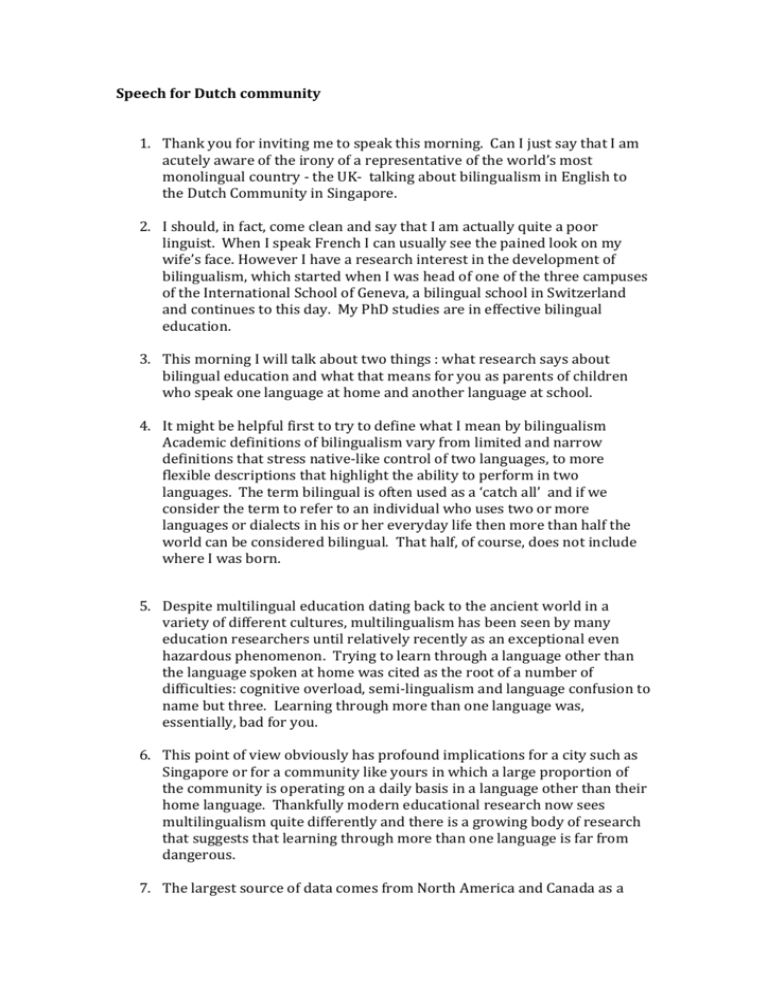
Speech for Dutch community 1. Thank you for inviting me to speak this morning. Can I just say that I am acutely aware of the irony of a representative of the world’s most monolingual country - the UK- talking about bilingualism in English to the Dutch Community in Singapore. 2. I should, in fact, come clean and say that I am actually quite a poor linguist. When I speak French I can usually see the pained look on my wife’s face. However I have a research interest in the development of bilingualism, which started when I was head of one of the three campuses of the International School of Geneva, a bilingual school in Switzerland and continues to this day. My PhD studies are in effective bilingual education. 3. This morning I will talk about two things : what research says about bilingual education and what that means for you as parents of children who speak one language at home and another language at school. 4. It might be helpful first to try to define what I mean by bilingualism Academic definitions of bilingualism vary from limited and narrow definitions that stress native-like control of two languages, to more flexible descriptions that highlight the ability to perform in two languages. The term bilingual is often used as a ‘catch all’ and if we consider the term to refer to an individual who uses two or more languages or dialects in his or her everyday life then more than half the world can be considered bilingual. That half, of course, does not include where I was born. 5. Despite multilingual education dating back to the ancient world in a variety of different cultures, multilingualism has been seen by many education researchers until relatively recently as an exceptional even hazardous phenomenon. Trying to learn through a language other than the language spoken at home was cited as the root of a number of difficulties: cognitive overload, semi-lingualism and language confusion to name but three. Learning through more than one language was, essentially, bad for you. 6. This point of view obviously has profound implications for a city such as Singapore or for a community like yours in which a large proportion of the community is operating on a daily basis in a language other than their home language. Thankfully modern educational research now sees multilingualism quite differently and there is a growing body of research that suggests that learning through more than one language is far from dangerous. 7. The largest source of data comes from North America and Canada as a result of immersion. People like Fred Genesee and Ellan Bialystock are probably the biggest names in this area and their studies show that : 8. Children in immersion programs attain native-like receptive skills and develop much higher levels of language proficiency than non-immersion students. Children perform at a satisfactory level in the subject matter taught in the second language, assimilating this knowledge at the same level as the mono- lingual control groups. The development of the mother tongue language is not affected, and students do not demonstrate significant problems in their first language. There seem to be cognitive advantages for learners and that this is independent of which languages are involved 9. Interestingly, late immersion students have been found to attain the same level of second language proficiency as early immersion students, despite having received significantly less exposure to the second language, perhaps due to their greater cognitive maturity and learning efficiency. 10. Research in education in Europe now seems to be centering on a particular approach known as CLIL – Content and Language Integrated Learning. In this students learn the second language while taking part in their science or history or maths lessons. The teacher or teachers have a dual focus: subject matter and language. There are a considerable number of programmes in the Scandinavian countries, Italy, Spain, France, Switzerland and the Netherlands. 11. Again the research from this is very positive with students showing advances in language learning without there being any detrimental effect on the subject of study. As one might perhaps expect, speakers of multiple languages also learn further languages more easily – they seem have a higher metalinguistic awareness (in other words, they show a better understanding of the nature of linguistic structures). 12. What is interesting, however, as more data is gathered is that, according to Laurent Gajo, a professor at the University of Geneva, research is suggesting that a ‘uniqueness’ exists in the development of multilingual students when compared to their monolingual peers.. In Gajo’s view of learning, the different languages interact and combine to generate, not the simple addition of distinct competences (i.e. not just two monolingual halves welded together), but rather an original, individual, complex competence on which the user may draw. 13. Advances in imaging technology have allowed researchers to look for differences in the neuro-circuitry of the monolingual and multilingual minds. Coggins, in 2004, for example found that ‘monolingual and bilingual groups exhibited significant differences in the corpus callosum midsagittal anterior mid-body regional area’ and went on to suggest that ‘with respect to second language education, the results of this study could suggest that bilingual learning could have a profound affect on brain structures in general and the corpus callosum in particular’. Osterhout in 2008 also reported preliminary results from three studies indicating that classroom based 2nd language instruction can result in changes in the brain’s electrical activity, in the location of this activity within the brain, and in the structure of the learners’ brains. 14. Of course it is not necessarily the case that changes in the structure of the brain or in the location of activity bring about superior performance. The two may well be unconnected. Be that as it may, there are a number of research articles that suggest that there are differences in ability and that a plurilingual person is not a monolingual with two (or more) languages. Indeed Cook said ‘These subtle differences consistently suggest that people with multicompetence are not simply equivalent to two monolinguals but are a unique combination so the multicompetence state yields more than the sum of its parts. 15. One study found that when monolingual and plurilingual subjects were presented with complex tasks, plurilinguals had the advantage: ‘The distracting influences confuse monolinguals, whereas the bilinguals were more able to resist the distractions of the irrelevant information. This was not the case when the groups handled relatively less demanding tasks and one might suggest that it is not that plurilinguals have a clear overall advantage but that they are better at handling the cognitive demands involved. They are, perhaps, simply more able to handle multiple tasks. 16. It is important to say that learning through a language other than your home language is not an easy option or one that will yield instant results. Though many children attain basic communicative competence in a language relatively quickly, the more specific language demanded in an educational setting takes longer to acquire and most students initially see a drop in their overall performance as they try to adjust. Much will depend on personal factors such as motivation, the child’s communicative needs and levels of anxiety, however, in the medium term, the drop is usually compensated for. Over time a multilingual child usually regains their age-appropriate progress, often times surpassing their monolingual peers. 17. The language barrier remains one of the great worries of being a parent overseas: how will your children cope with learning (and living) in a context in which the language you speak with them at home is a ‘minority language’? It is not at all unusual for me to talk to concerned parents who are worried that speaking their home language with their children will at best slow down their progress in the language spoken at school or at worst confuse them so that they end up speaking no first language at all. Should they, they ask, speak English at home? Is it wrong to speak Japanese? 18. No. For a child learning in a second language there is considerable research on the vital important of maintaining their mother tongue. Skills acquired in the first language can be transferred to the second language so, for example, if your child has developed good reading skills in Dutch , she is likely to be able to apply these skills when reading English. (One useful reading skill is the ability to guess the meaning of unfamiliar words from context). For this reason it helps if you can encourage your child to read good fiction and non-fiction in her own language. Similarly, the skills of being able to plan out a piece of writing or develop an argument in a persuasive essay can be applied in the second language once they have been learned in the first 19. Many children in international schools also plan to return to their home country at some point to continue their education there. Students who turn against or otherwise neglect their mother tongue can often suffer from problems of identity loss or distance from their parents, and from their grandparents or other family members in their home country. Both of these are strong reasons to make sure they do not have gaps in their mother tongue. 20. Educational research has generated more than its fair share of false conclusions – playing Bach to your children and having pot plants in the classroom does not necessarily make them better at mathematics. It is important to recognize that the range of factors that go together to generate the positive consequences of multilingualism are not as yet fully understood; the choices of the institution (for instance, its language curricula and its teaching methodology will also have a critical influence on a learners’ willingness, or reluctance, to transfer resources from one context into another. 21. What is clear, however, is the importance of the strategic and transferable skills that multilingualism can bring and the extraordinary opportunity that living in such a linguistically diverse city as Singapore presents to our children as they face an increasingly complex and rapidly changing world.
